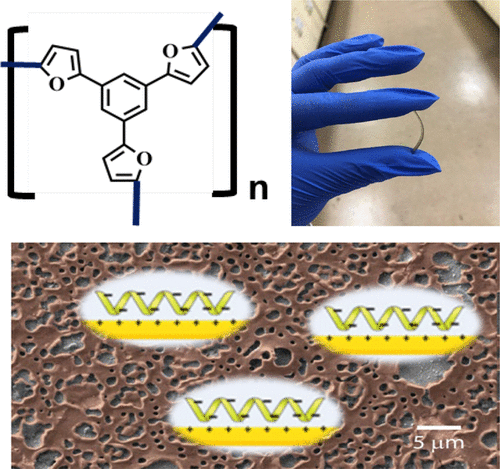当前位置:
X-MOL 学术
›
ACS Appl. Polym. Mater.
›
论文详情
Our official English website, www.x-mol.net, welcomes your feedback! (Note: you will need to create a separate account there.)
Electropolymerized Porous Polymer Films on Flexible Indium Tin Oxide Using Trifunctional Furan Substituted Benzene Conjugated Monomer for Biosensing
ACS Applied Polymer Materials ( IF 5 ) Pub Date : 2020-02-04 , DOI: 10.1021/acsapm.9b00826 Supreetha Paleyanda Ponnappa 1 , Jennifer Macleod 1 , Muhammad Umer 2 , Narshone Soda 3 , Amandeep Singh Pannu 1 , Muhammad J. A. Shiddiky 2, 3 , Godwin A. Ayoko 1 , Anthony P. O’Mullane 1 , Prashant Sonar 1
ACS Applied Polymer Materials ( IF 5 ) Pub Date : 2020-02-04 , DOI: 10.1021/acsapm.9b00826 Supreetha Paleyanda Ponnappa 1 , Jennifer Macleod 1 , Muhammad Umer 2 , Narshone Soda 3 , Amandeep Singh Pannu 1 , Muhammad J. A. Shiddiky 2, 3 , Godwin A. Ayoko 1 , Anthony P. O’Mullane 1 , Prashant Sonar 1
Affiliation

|
In recent years, conducting polymers are playing a significant role in the field of display devices, transistors, solar cells, sensors, and electrochromic windows due to their outstanding optoelectronic and semiconducting properties due to their conjugated backbone. One potential application that is not as widely explored using these materials is biosensing, where advantage is taken of the porosity that can be generated by the polymerization of a three-dimensional network. There are various approaches for producing conjugated microporous polymers using trifunctional or multifunctional monomers synthesized via chemical or electrochemical methods. In this work, we have used electropolymerization to synthesize conjugated polymer films on a working electrode of flexible indium tin oxide (FITO) using a trifunctional conjugated monomer 1,3,5-tri(furan-2-yl)benzene (TFB). There are several parameters that influence the formation of a porous polymer film, and the most critical ones are substrate conductivity, roughness, method of electropolymerization, and choice of an electrolyte. These porous electropolymerized films were characterized using UV–vis spectroscopy (UV–vis), X-ray photoelectron spectroscopy (XPS), surface profilometry, four-point probe conductivity measurements, and scanning electron microscopy (SEM). The polymer films that were electropolymerized using chronoamperometry rather than repetitive potential cycling demonstrated a more suitable morphology to trap DNA/RNA analytes for biosensing applications.
中文翻译:

三官能呋喃取代苯共轭单体在柔性氧化铟锡上的电聚合多孔聚合物膜的生物传感
近年来,由于其共轭主链具有出色的光电和半导体特性,导电聚合物在显示设备,晶体管,太阳能电池,传感器和电致变色窗领域中发挥着重要作用。使用这些材料尚未广泛探索的一种潜在应用是生物传感,其中利用了可通过三维网络聚合生成的孔隙率。存在使用通过化学或电化学方法合成的三官能或多官能单体生产共轭微孔聚合物的各种方法。在这项工作中,我们使用电聚合技术在使用三官能共轭单体1,3的柔性铟锡氧化物(FITO)的工作电极上合成了共轭聚合物膜,5-三(呋喃-2-基)苯(TFB)。有几个参数会影响多孔聚合物膜的形成,最关键的参数是基材的电导率,粗糙度,电聚合方法和电解质的选择。这些多孔电聚合膜的特征在于使用了紫外可见光谱(UV-vis),X射线光电子能谱(XPS),表面轮廓测定法,四点探针电导率测量和扫描电子显微镜(SEM)。使用计时电流法而不是重复电势循环进行电聚合的聚合物膜表现出更合适的形态来捕获DNA / RNA分析物用于生物传感应用。电聚合的方法和电解质的选择。这些多孔电聚合膜的特征在于使用了紫外可见光谱(UV-vis),X射线光电子能谱(XPS),表面轮廓测定法,四点探针电导率测量和扫描电子显微镜(SEM)。使用计时电流法而不是重复电势循环进行电聚合的聚合物膜表现出更合适的形态来捕获DNA / RNA分析物用于生物传感应用。电聚合的方法和电解质的选择。这些多孔电聚合膜的特征在于使用了紫外可见光谱(UV-vis),X射线光电子能谱(XPS),表面轮廓测定法,四点探针电导率测量和扫描电子显微镜(SEM)。使用计时电流法而不是重复电势循环进行电聚合的聚合物膜表现出更合适的形态来捕获DNA / RNA分析物用于生物传感应用。
更新日期:2020-02-04
中文翻译:

三官能呋喃取代苯共轭单体在柔性氧化铟锡上的电聚合多孔聚合物膜的生物传感
近年来,由于其共轭主链具有出色的光电和半导体特性,导电聚合物在显示设备,晶体管,太阳能电池,传感器和电致变色窗领域中发挥着重要作用。使用这些材料尚未广泛探索的一种潜在应用是生物传感,其中利用了可通过三维网络聚合生成的孔隙率。存在使用通过化学或电化学方法合成的三官能或多官能单体生产共轭微孔聚合物的各种方法。在这项工作中,我们使用电聚合技术在使用三官能共轭单体1,3的柔性铟锡氧化物(FITO)的工作电极上合成了共轭聚合物膜,5-三(呋喃-2-基)苯(TFB)。有几个参数会影响多孔聚合物膜的形成,最关键的参数是基材的电导率,粗糙度,电聚合方法和电解质的选择。这些多孔电聚合膜的特征在于使用了紫外可见光谱(UV-vis),X射线光电子能谱(XPS),表面轮廓测定法,四点探针电导率测量和扫描电子显微镜(SEM)。使用计时电流法而不是重复电势循环进行电聚合的聚合物膜表现出更合适的形态来捕获DNA / RNA分析物用于生物传感应用。电聚合的方法和电解质的选择。这些多孔电聚合膜的特征在于使用了紫外可见光谱(UV-vis),X射线光电子能谱(XPS),表面轮廓测定法,四点探针电导率测量和扫描电子显微镜(SEM)。使用计时电流法而不是重复电势循环进行电聚合的聚合物膜表现出更合适的形态来捕获DNA / RNA分析物用于生物传感应用。电聚合的方法和电解质的选择。这些多孔电聚合膜的特征在于使用了紫外可见光谱(UV-vis),X射线光电子能谱(XPS),表面轮廓测定法,四点探针电导率测量和扫描电子显微镜(SEM)。使用计时电流法而不是重复电势循环进行电聚合的聚合物膜表现出更合适的形态来捕获DNA / RNA分析物用于生物传感应用。


























 京公网安备 11010802027423号
京公网安备 11010802027423号